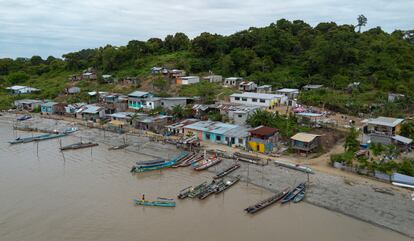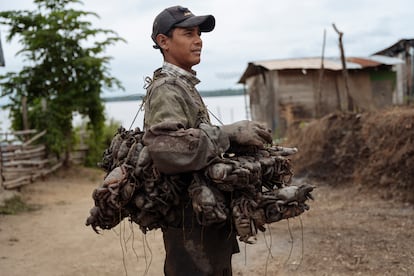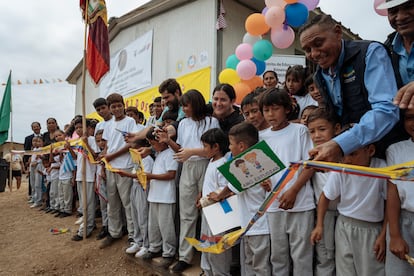Issac Chalén is 13 years old and getting ready for his first day of school. His uniform is impeccable, he shakes out his black sports shoes, takes a pen from an old backpack and walks quickly towards school. He is happy. He is sure that this time he will finish the school year. It’s not that he didn’t want to before, he likes to write and is proud when he says that he is good at math. But until that day, the commune where he lives, called Punta de Piedra, had not had a school and the difficulties in reaching the closest one has caused nine out of 10 children to abandon the school system. There are few young people who have finished high school. You can count them on your fingers. And those who have achieved it have been by sacrificing separation from their families to live in Guayaquil.
To get to Punta de Piedra you have to take a boat from the south of the city and navigate the Guayas River towards the Pacific. The section lasts an hour and a half, although it depends on the motor of the boat. The first inhabitants of Punta de Piedra were crab collectors who arrived 80 years ago, they raised some reeds, pieces of wood, straw and zinc on a piece of land that was surrounded by mangrove and river. It was the ideal place, because it meant living right next to the mangroves where they catch the crabs. They thought that over time they would have the modern and necessary services, such as electricity, drinking water and telephone signal. But decades later they continue to lack the basics, but they are no longer a handful of crabbers, but 150 inhabitants. The majority are minors.

Before their dream of having a school came true, Issac and 80 other school-age children had to travel half an hour by canoe from Punta de Piedra to another commune called Masa 2, where there are two classrooms with chairs and old tables, where a hundred children study intermittently. “We couldn’t go to classes every day because there aren’t always canoes to leave the community,” says Issac, and remembers that many times the small boat in which he was traveling was about to capsize with all the children on board, who were crowded together in an attempt to attend classes. Furthermore, as the weeks passed, the enthusiasm of any beginning of the school year dissipated due to poverty and the disappointment that the teachers did not always come to school to work, and the students were left alone in the classroom. “It costs a parent three dollars a day per child to pay for transportation, here there are families that have up to five children, it was impossible,” explains Agapito Vidal, president of the commune. Thus, at the end of each year, 90 percent of the enrolled students ended up dropping out, acknowledges the Undersecretary of Education, Daniela Febres Cordero. Of the 24 communes that are in the Gulf of Guayaquil, Punta de Piedra is one of the ones with the most inhabitants. “The logical thing is that there is a school here to reintegrate children into the school system,” she adds.

Rigoberto, 35, looks out the window of the newly opened salon at his five-year-old son. “He is very happy playing, he is the first in line, the one with the blocks: Axel Solórzano,” he points to him to identify him. “Axel, say hello my love!” He shouts to get his attention and the boy just smiles and waves back to go back to playing with the blocks. “What were we going to imagine that we could play with those toys?” says Rigoberto with a laugh that mixes innocence and nostalgia. “When we were children we played to collect crabs and fish. We help row the canoes during the work. “That’s what we learned,” he says, and it’s what he has also taught his son. “Dad, I’ll tie them up,” my son tells me. And it’s the only thing I can teach him because I didn’t finish school.” In Punta de Piedra all the men are dedicated to collecting crabs, none of them finished school. Most of them reached third grade, learned to read the basics, write names and numbers, and did not continue. Axel, at five years old, has already participated in the work, he has rowed the boat to the shore of the enormous roots of the mangrove, dressed in rubber boots and covered his entire body with clothing, without leaving a space of skin so that he does not get stung. the swarms of mosquitoes.

The community members of Punta de Piedra worked for eight months removing the earth with pick and shovel where they built the first four classrooms. This school was the last hope for some families before deciding to migrate from the commune. They want a different future for children, and a move away from the insecurity that also threatens Gulf communities. Nobody wants to talk about that topic. When asked, they immediately fall silent and the conversation ends. The authorities have identified the criminal groups that sow terror in communities through threats and extortion. They know that all fishermen pay the vaccines (extortions), but they justify not having control of the security of the Gulf because they do not have sufficient resources to monitor the extensive Guayas River. The criminals arrive as armed pirates and in boats faster than those the Ecuadorian Navy has. Helpless and uncertain, about 30 people have abandoned their homes, nets and canoes and left Punta de Piedra. For those who have stayed, school is a sign that they can still change the future, at least that is what the adults who have that sparkle in the eyes of someone who wants to burst into tears want to believe. The impatient students cut the ribbon and ran to their new colorful classrooms, with a blackboard, books, and where there were teachers waiting for them.

Follow all the information from El PAÍS América in Facebook and xor in our weekly newsletter.
#built #school #crabbers #Guayaquil #built #hands